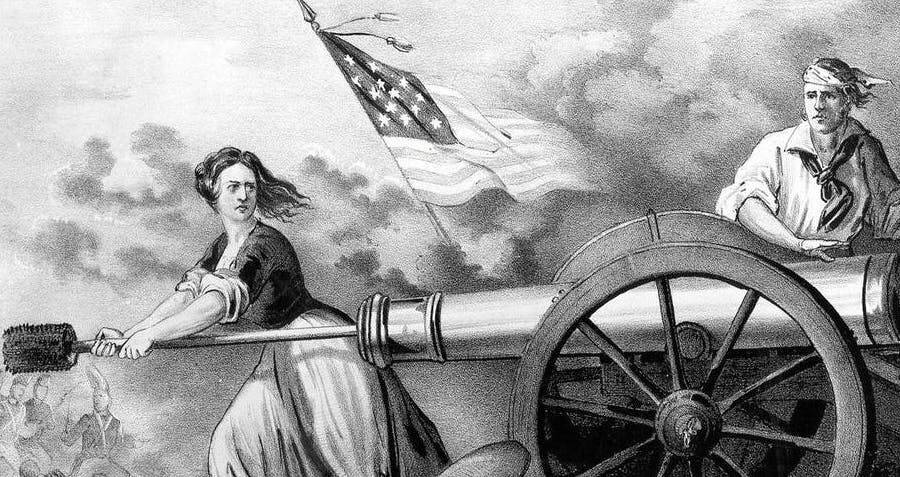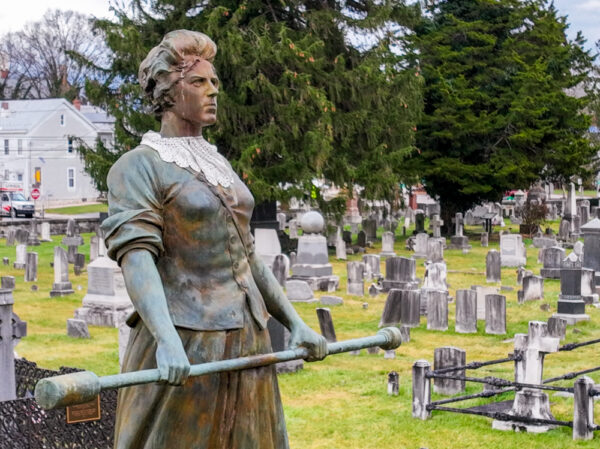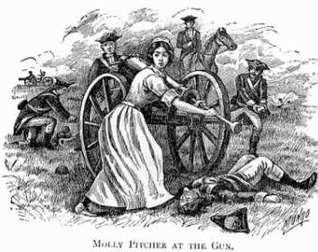Growing up, you likely heard the story of Molly Pitcher. The story remarks on a brave young woman who entered the Battle of Monmouth to bring water to her husband’s battery to cool the cannons. While on the battlefield, the legend shows that when her husband fell wounded, she took up his cannon for the remainder of the battle. This story has been passed down through the generations, but did you know that “Molly Pitcher” is based on a real story?
Mary Ludwig Hays, who is thought to have been born in Trenton, is the inspiration behind the tale of Molly Pitcher. She was born on October 13th, 1754. Although the exact spot of her birth is unknown, she is thought to have been born near her father’s dairy farm, which has been traced back to the Trenton region. Mary lived and worked on this farm with her family until she was 15. Then, in 1769, Mary’s father arranged for her to work as a servant for Dr. William Irvine of Carlisle, PA. As a result, Mary moved 100 miles away and spent her days tending to Dr. Irvine and his family. Mary could make money and support her family back home through this job.
While Mary was in Carlisle, she met a young barber named William Hays. The pair fell in love and were married on July 24th, 1769, at the Irvine residence. Just a few short years later, the Revolutionary War was officially underway. At the start of the war, William Hays enlisted with Captain Francis Proctor’s Company in the Pennsylvania Artillery. During his time in the service, William was assigned to the cannons. He would spend his days hauling ammunition, loading cannons, and firing them toward enemy lines. When William was relocated to an Army camp, Mary accompanied him.
While Mary was on base with William, she became what is referred to as a “camp follower.” These individuals, who were typically family or spouses of the troops, would tend to soldiers, including laundry, meals, and medical care. Mary quickly jumped into the fray, tending to ill soldiers and helping with some day-to-day tasks. When asked about Mary’s demeanor, soldiers on the base recalled she was a “twenty-two-year-old illiterate pregnant woman who smoked and chewed tobacco and swore as well as any of the male soldiers.” However, it is documented that Mary was well-liked amongst the troops for her work ethic and ability to step up in times of trouble.
During the Battle of Monmouth, Mary’s bravery and efforts would land her story among that legends. It was mid-June, and both temperatures and tensions were running high. About 50 soldiers were estimated to be lost that day due to extreme heat and dehydration. Despite this muggy weather, Mary spent all day running back and forth from a local spring to fetch water and bring it to the overheated troops. It is here that she likely earned the nickname “Molly Pitcher.” She continued these efforts until her husband, William, fell victim to the heat and collapsed.

When William collapsed, Mary decided to take up the cannon in his place. Mary crewed the station for the remainder of the Battle of Monmouth and fearlessly fought alongside Washington’s troops. It is stated that a fellow soldier, Joseph Plumb, recalled that while Mary was loading a cannon, it fired and tore a cannonball directly through the bottom of her petticoat. However, she was unharmed and continued to fight. Although this cannot be proven, legend has it that George Washington inquired of the woman on the battlefield, thanked her for her bravery, and allegedly even declared her a sergeant, earning her the nickname “Sergeant Molly.”
After the war, Mary and William returned to Carlisle, PA, where they would have their first child, John L. Hays. In 1789, William Hays passed away, leaving Mary a widow. She went on to remarry John McCauley. In 1822, Mary applied for a pension as a soldier’s widow. However, rather than providing her with the typical pension, the State of Pennsylvania awarded Mary an annual $40 for “her services during the Revolutionary War.” Although it is not explicitly stated what those services were, it does further exemplify the extent of Mary’s efforts during the war.
Mary lived until 79, when she passed away in Carlisle, PA. To this day, Mary has monuments in both Monmouth County, NJ, and Carlisle to commemorate her bravery. She was buried at the Carlisle Old Graveyard, where her headstone is marked “Molly Pitcher” with a cannon and a statue above her grave. Mary, specifically the legend of “Molly Pitcher,” is widely regarded as one of the premier female figures of the Colonial Era. As a Jersey girl with roots in Trenton, we can proudly call Mary Hays one of our own. During this Women’s History Month, may we uplift the stories of those like Mary, whose tenacity and courage continue to inspire generations of women today.

SOURCES:
- https://www.womenshistory.org/education-resources/biographies/mary-ludwig-hays
- https://www.britannica.com/biography/Molly-Pitcher
- https://pennsylvaniapeople.weebly.com/mary-ludwig-hays-mccauley-level-2.html
- https://www.battlefields.org/learn/biographies/molly-pitcher
- https://www.history.com/news/who-was-molly-pitcher






